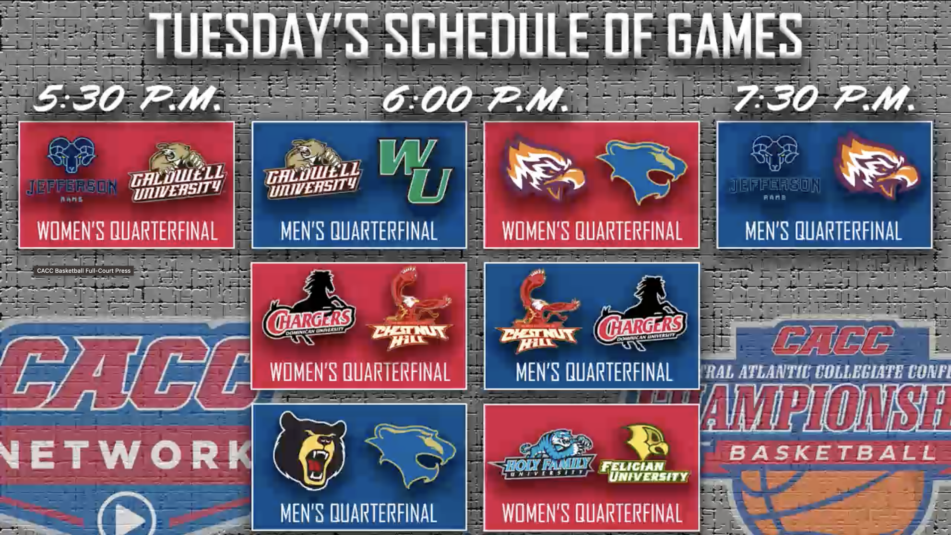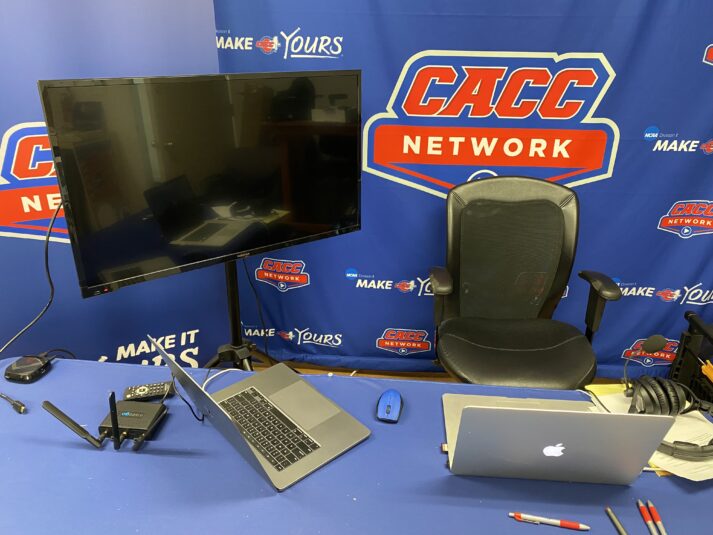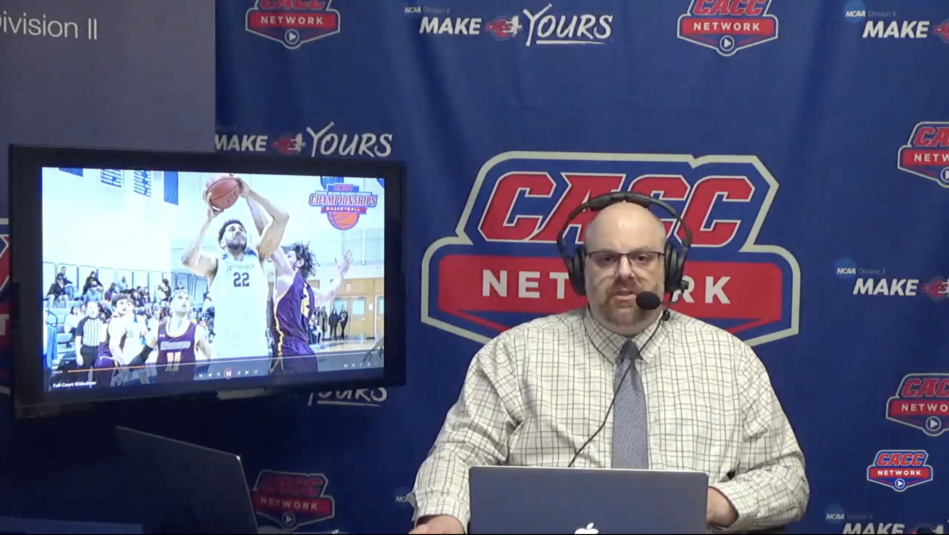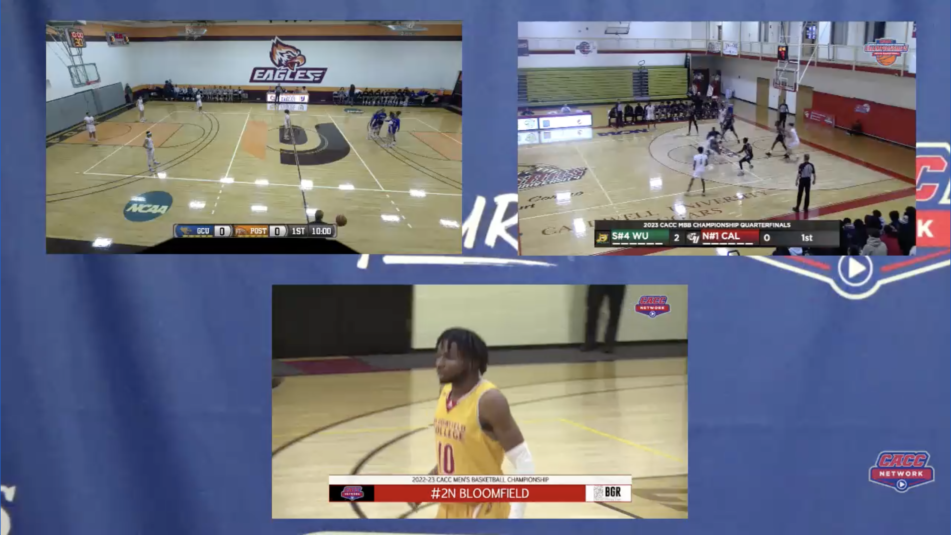Central Atlantic Collegiate Conference Deploys Full Court Press for Men’s, Women’s Basketball Quarterfinals
The Division II conference streamed live broadcasts of eight games happening simultaneously
Story Highlights
It’s postseason time in college basketball, and, as fans across the nation gear up for the run to the NCAA’s Final Four, March Madness isn’t reserved for Division I. In Division II, the Central Atlantic Collegiate Conference (CACC) — a 13-member conference that competes in New York, New Jersey, Connecticut, Pennsylvania, and Delaware — stoked the fanbase with its broadcast of the quarterfinals of its men’s and women’s tournaments. Dubbed Full Court Press, the NFL Red Zone-esque program gave fans live look-ins of all eight games occurring simultaneously.
“We’ve always asked ourselves what we could do to add more content,” says Doug DeBiase, associate commissioner, strategic communications, CACC. “We’ve wanted to create material that would differentiate ourselves from other conferences for the past four or five years, but this specific endeavor sprung up in the past two months.”
Constantly Evolving: CACC Network Is Basis for Full Court Press
Since joining the CACC in the summer of 2014, DeBiase has looked to upgrade the conference’s video-production and live-streaming capabilities. With a background in Division I athletics at the University of Maine and a Division II program at Franklin Pierce University, he understands the value of broadcasting games to a dedicated fanbase. Unfortunately, when he began his work at the CACC, the resources weren’t available for each sport’s regular season.

Full Court Press covered eight men’s and women’s games played during the CACC Quarterfinals on Feb. 28.
“We were mainly focused on the live streams of all of our championships and linking them to our conference [and each institution’s] website,” he says. “We started seeing Division II and Division III work with various apps — including Roku, Fire TV, and others — to modernize their live streaming and bring every game to their fans.”
With each of the 13 institutions leveraging its own live-streaming network, the first order of business was to bring the athletic programs together on one system. With the goal of providing as many games as possible to fans, the CACC Network came online in 2018 as the conference’s official live-streaming home.
DeBiase and his team worked with BlueFrame Technology to optimize the platform and assist every school with uploading its live video signals for distribution. In January, after extending the partnership for another five years, the conference refined its technological and production skills and, able to pull in multiple broadcast feeds, used the six weeks leading up to the quarterfinals on Feb. 28 to practice what became Full Court Press.
“It’s the first time we’ve done a show like this,” DeBiase explains. “When there were several games going on at once, I would set up a test broadcast to work on seamlessly cutting from one game to another. I tried to build that muscle memory, so that, when we went to the live broadcast, I would know how to quickly bring up multiple games without much of a delay.”
Flying Solo: Inside DeBiase’s Operation, Production in New Haven, CT
On the night of the broadcast, DeBiase relied on the typical workflow of the CACC Network: the sports information directors of the seven host schools — Chestnut Hill College, Jefferson University, Caldwell University, Bloomfield College, Post University, Dominican College, and Holy Family University — set up their onsite infrastructure and created a dedicated RTMP link for each game. Once that was established, the conference uploaded each feed into BlueFrame Technology’s Production Truck live-streaming software on a laptop as a makeshift production switcher. With games beginning at 5:30 p.m. ET, the 30-minute pregame show integrated commercial breaks highlighting the conference and each school. When the frenzy kicked off, up to three games could be shown at once, and games that went full-screen included real-time audio from the play-by-play announcer and instant replays.
Moving among eight simultaneous games in 1½ hours is difficult, but a wrinkle that fans weren’t able to see made the job a lot harder: DeBiase assumed the role of both director and on-air talent. Operating from 10- x 12-ft. office space at conference headquarters in New Haven, CT, with a conference-themed backdrop and a TV monitor with rotating images as the broadcast studio, he found the biggest challenge to be figuring out the cadence, rhythm, and pace of the broadcast.
“I was able to watch four games at one time in the software,” he says, “but, since there weren’t as many close games as we would have liked, [the broadcast] was a lot easier without having to jump back and forth between eight games. If another game was getting close, we let the viewers know that they’d be taken to that game shortly. It was all about taking it one step at a time and keeping our fans updated.”
After the broadcast went off the air around 9:30 p.m., the conference registered 1,500 unique viewers and an increase in website traffic. Looking back on the broadcast, DeBiase would take some responsibilities off his plate to streamline and simplify the live stream a bit more. This would allow him to be in control solely of getting graphics on-air in a timely manner and insert cleaner transitions from game to game.
“With the success of the network over the past few years,” he says, “I’ve been able to hire announcers for all of our championships. After reporting back to Commissioner Dan Mara and the athletic directors, I can bring someone in to help with this next year if they feel that it’s worth the investment.”
Possible Expansion: Conference Sees Potential for Other Sports
Now that the dust has settled, he sees endless possibilities for other editions of the broadcast. With indoor sports like basketball and volleyball more easily covered given their consistent source of power and internet access, the next step would be to provide adequate infrastructure for outdoor sports — soccer, lacrosse, baseball, softball — to pursue their own versions of Full Court Press.
“I would like to do this for more sports,” says DeBiase. “I think it’s definitely possible. Our schools do a great job with outdoor sports, so a ton of credit goes to them for finding a way to live-stream games. I’d also love to do this for the final day of the regular season since we always have seeding matchups determined by the results of those games.”
Overall, Full Court Press marks a watershed moment for the CACC as well as for other Division II conferences. Not only are fans of each school getting to watch their fellow student-athletes participate and excel in the playoffs, but the digital platform and the production concept can improve the visibility of the conference as a whole.
“From a coaching perspective,” adds DeBiase, “it’ll help with recruiting if this is something that a lot of high school athletes tune into. This is a chance for fans to pick a team that they’d like to follow, and, moving forward, they could gain a lot more interest in Division II basketball.”
Caldwell University defeated Jefferson University in the CACC final to advance to the NCAA Division II Men’s Basketball Championship and were defeated by University of New Haven in the second round. Dominican College defeated Post University in the CACC final to advance to the NCAA Division II Women’s Basketball Championship and lost to Assumption University in the first round.



